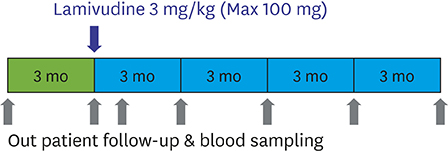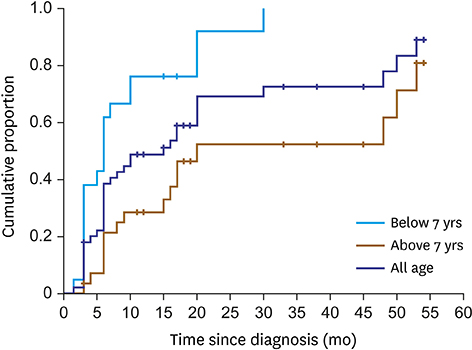Pediatr Infect Vaccine.
2018 Aug;25(2):72-81. 10.14776/piv.2018.25.e2.
Therapeutic Efficacy of Lamivudine in Children and Adolescents with Chronic Hepatitis B
- Affiliations
-
- 1Department of Pediatrics, St. Vincent's Hospital, College of Medicine, The Catholic University of Korea, Seoul, the Republic of Korea. jh00mn@catholic.ac.kr
- KMID: 2418539
- DOI: http://doi.org/10.14776/piv.2018.25.e2
Abstract
- PURPOSE
This prospective study aimed to investigate the therapeutic efficacy of lamivudine in children with chronic hepatitis B virus (HBV) infection.
METHODS
During July 2003 through October 2015, children with chronic hepatitis B who visited our institution were included in this study. Fifty-five patients, who received first-line treatment of lamivudine (3 mg/kg, 100 mg maximum) for over three months, were enrolled. After initiating lamivudine, alanine aminotransferase (ALT), HBV-DNA, and HBV markers were followed up at 1 month, 3 months, and every 3 months, thereafter. The treatment endpoint was determined as 1) normalization of ALT, 2) HBeAg seroconversion, and 3) anti-HBe positivity for twelve consecutive months.
RESULTS
Thirty-one male (56.4%) and 24 female (43.6%) patients were included. The mean age at treatment initiation was 8.1 years. The mean duration of treatment was 23.4 months. ALT normalization was found in 98.2% (54 of 55). Anti-HBe seroconversion was found in 70.6% (36/51). Loss of HBsAg was found in 10.9% (6/55). All biochemical responses occurred under age seven. The rate of virologic response (defined as HBV-DNA <2,000 IU/mL) at six months after treatment initiation was 78.7% (37/47). At twelve months after reaching treatment endpoint, 87.2% (34/39) maintained their virologic response. Resistance to lamivudine was found in 16.4% (9/55).
CONCLUSIONS
Lamivudine treatment in Korean pediatric patients with chronic hepatitis B showed better outcomes compared with other studies that implemented similar protocols in foreign populations. Further studies are needed to investigate the efficacy of newly recommended antiviral drugs on the Korean pediatric population.
Keyword
MeSH Terms
Figure
Reference
-
1. Moradpour D, Wands JR. Understanding hepatitis B virus infection. N Engl J Med. 1995; 332:1092–1093.
Article2. World Health Organization. Guidelines for the prevention, care and treatment of persons with chronic hepatitis B virus infection. Geneva: World Health Organization;2015. p. 10–12.3. Chae HB, Kim JH, Kim JK, Yim HJ. Current status of liver diseases in Korea: hepatitis B. Korean J Hepatol. 2009; 15:Suppl 6. S13–S24.
Article4. Hong SG, Soh JW, Oh JH. Statistical and histological studies on HBsAg in grade-school childrens. J Korean Pediatr Soc. 1979; 22:433–442.5. Han JY, Jung TW, Koh DK, Kim JH. A survey for changed control policies of hepatitis B in the Republic of Korea. Korean J Pediatr Infect Dis. 2011; 18:124–134.
Article6. Ministry of Health and Welfare, Korea Centers for Disease Control and Prevention. Korea Health Statistics 2014: Korea National Health and Nutrition Examination Survey (KNHANES VI-2). Sejong: Ministry of Health and Welfare;2015.7. Kim JH, Seo K, Kim HM. A comparative study for the outcome of perinatal hepatitis B prophylaxis according to the dosages of hepatitis B immunoglobulin. Seoul: Korea Centers for Disease Control and Prevention;2006.8. Chang MH, Hsu HY, Hsu HC, Ni YH, Chen JS, Chen DS. The significance of spontaneous hepatitis B e antigen seroconversion in childhood: with special emphasis on the clearance of hepatitis B e antigen before 3 years of age. Hepatology. 1995; 22:1387–1392.
Article9. Chang MH, Chen TH, Hsu HM, Wu TC, Kong MS, Liang DC, et al. Prevention of hepatocellular carcinoma by universal vaccination against hepatitis B virus: the effect and problems. Clin Cancer Res. 2005; 11:7953–7957.
Article10. Perrillo RP. Treatment of chronic hepatitis B with interferon: experience in western countries. Semin Liver Dis. 1989; 9:240–248.
Article11. Sokal EM, Paganelli M, Wirth S, Socha P, Vajro P, Lacaille F, et al. Management of chronic hepatitis B in childhood: ESPGHAN clinical practice guidelines: consensus of an expert panel on behalf of the European Society of Pediatric Gastroenterology, Hepatology and Nutrition. J Hepatol. 2013; 59:814–829.
Article12. Korean Association for the Study of the Liver. 2015 Clinical practice guideline: chronic hepatitis B. Seoul: Korean Association for the Study of the Liver;2015. p. 123–126.13. Jonas MM, Chang MH, Sokal E, Schwarz KB, Kelly D, Kim KM, et al. Randomized, controlled trial of entecavir versus placebo in children with hepatitis B envelope antigen-positive chronic hepatitis B. Hepatology. 2016; 63:377–387.
Article14. European Association for the Study of the Liver. EASL 2017 Clinical Practice Guidelines on the management of hepatitis B virus infection. J Hepatol. 2017; 67:370–398.15. Jang YC, Cho MH, Choe BH. Three years' cumulative therapeutic efficacy and long-term durability of lamivudine in Korean children with chronic hepatitis B. Korean J Pediatr Gastroenterol Nutr. 2004; 7:197–207.
Article16. Lee EH, Jang JY, Kim KM. Efficacy of lamivudine therapy for chronic hepatitis B in children. Korean J Pediatr Gastroenterol Nutr. 2008; 11:130–136.
Article17. Koh H, Baek SY, Chung KS. Lamivudine therapy for Korean children with chronic hepatitis B. Yonsei Med J. 2007; 48:927–933.
Article18. Jung AN, Jung HK, Choi SK, Park CO. The comparison of sequencing method with restriction fragment mass polymorphism method for the detection of HBV YMDD mutants. Korean J Clin Lab Sci. 2005; 37:173–177.19. Cheon JH, Park JW, Park KW, Kim YI, Kim SH, Lee WJ, et al. The clinical report of 1,078 cases of hepatocellular carcinomas: National Cancer Center experience. Korean J Hepatol. 2004; 10:288–297.20. Yang HI, Park EY, Kim MY. National immunization survey in South Korea, 2013. Public Health Wkly Rep. 2014; 7:449–454.21. Lok AS, McMahon BJ. Chronic hepatitis B. Hepatology. 2007; 45:507–539.
Article22. Hong SJ, Park HJ, Chu MA, Choi BS, Choe BH. The rate of conversion from immune-tolerant phase to early immune-clearance phase in children with chronic hepatitis B virus infection. Pediatr Gastroenterol Hepatol Nutr. 2014; 17:41–46.
Article23. Dienstag JL, Schiff ER, Wright TL, Perrillo RP, Hann HW, Goodman Z, et al. Lamivudine as initial treatment for chronic hepatitis B in the United States. N Engl J Med. 1999; 341:1256–1263.
Article24. Jonas MM, Kelley DA, Mizerski J, Badia IB, Areias JA, Schwarz KB, et al. Clinical trial of lamivudine in children with chronic hepatitis B. N Engl J Med. 2002; 346:1706–1713.
Article25. Sokal EM, Kelly DA, Mizerski J, Badia IB, Areias JA, Schwarz KB, et al. Long-term lamivudine therapy for children with HBeAg-positive chronic hepatitis B. Hepatology. 2006; 43:225–232.
Article26. Moyes CD, Milne A, Waldon J. Liver function of hepatitis B carriers in childhood. Pediatr Infect Dis J. 1993; 12:120–125.
Article27. Hwang SH, Kim JH, Kang JH, Hur JK, Lee KI, Oh JH, et al. Follow-up of children with chronic hepatitis B virus infection. Korean J Pediatr Infect Dis. 2004; 11:73–80.
Article28. Lok AS, Lai CL, Wu PC, Leung EK, Lam TS. Spontaneous hepatitis B e antigen to antibody seroconversion and reversion in Chinese patients with chronic hepatitis B virus infection. Gastroenterology. 1987; 92:1839–1843.
Article29. Yoon JH, Rhee PL, Lee HS, Kim CY. Spontaneous HBeAg clearance rate and its affecting factors inpatients with chronic hepatitis B in Korea. Korean J Gastroenterol. 1992; 24:1313–1319.30. Sampliner RE. The duration of hepatitis B surface antigenemia. Arch Intern Med. 1979; 139:145–146.
Article31. Hong SJ, Kim YH, Choe BH, Park HJ, Tak WY, Kweon YO. Current role of lamivudine regarding therapeutic response and resistance in children with chronic hepatitis B. Pediatr Gastroenterol Hepatol Nutr. 2013; 16:80–88.
Article
- Full Text Links
- Actions
-
Cited
- CITED
-
- Close
- Share
- Similar articles
-
- The Efficacy of Lamivudine in Korean Patients with Chronic Hepatitis B
- Experience with Entecavir Therapy for Lamivudine-Resistant Chronic Hepatitis B in Korean Children and Adolescents
- Comparison of Therapeutic Efficacy between Lamivudine and Alpha-Interferon in Korean Children with Chronic Hepatitis B at Two Years after the Initiation of Treatment
- The management and treatment of chronic hepatitis B in Korean children
- Three Years' Cumulative Therapeutic Efficacy and Long-term Durability of Lamivudine in Korean Children with Chronic Hepatitis B




